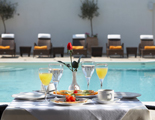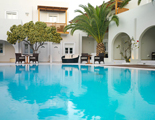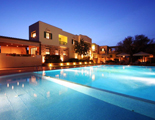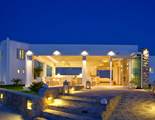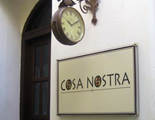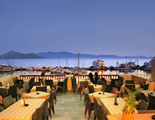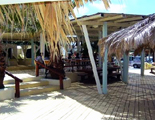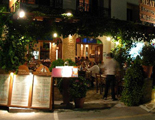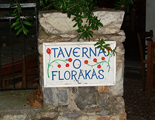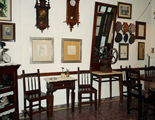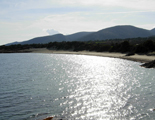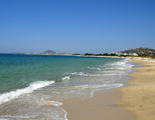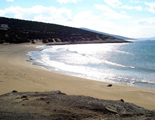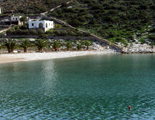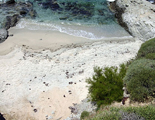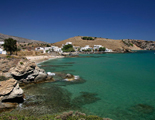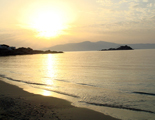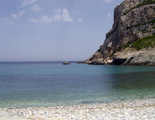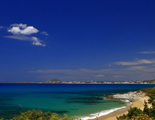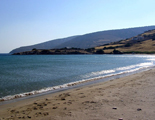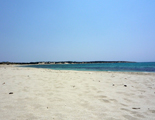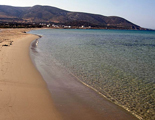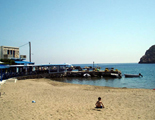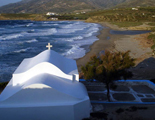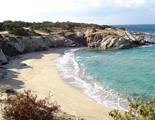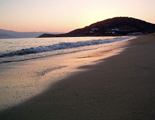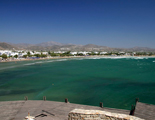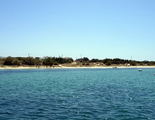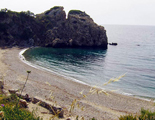 Naxos Travel Guide
Naxos Travel Guide
The myths and stories surrounding the island's past concerning Gods & other mythological creatures are not only numerous but represent "food" for the imagination of Naxian people and the island's visitors. It is said that Zeus himself sent his son Dionysus to Naxos in order to be brought up by the Nymphs Filia, Kleidi & Koroni. Moreover, one of the tallest mountains in the Cyclades, mount Zas (Zeus) in Filoti, was named after the king of Gods. At the foot of the mountain is Mount Zas Cave, in which Dionysus was brought up.
God Dionysus is believed to have lived on Naxos. Dionysus followers were the Satyrs (men followers) & Maenads (women followers) who were constantly dancing and drinking.
When Theseus, son of Poseidon, left Crete with Ariadne, the daughter of King Minoa, after killing the Minotaur, they arrived at Naxos and moored at Palatia, the little island connected to Naxos town, which was then called Dia after Zeus. According to the most popular myth, as Theseus and Ariadne were sleeping, Dionysus, who had seen Ariadne and had fallen in love with her, visited Theseus in his dream to tell him that he had chosen her to become his wife and demanded that he leave her on the island for him. Theseus, who was also in love with Ariadne, refused to leave her at first, but when Dionysus, who was after all a god, threatened him, he had no choice but to leave. The morning after, when Ariadne woke up and found Dionysus instead of Theseus, she started looking in vain for her beloved, Dionysus proposed her and offered her two gifts: wine from a golden cup and a golden crown with valuable stones made by Efestus. Ariadne, who was at first angry at Theseus for abandoning her, accepted Dionysus' proposal and left Naxos Island with him after their marriage.
God Apollo was also fondly worshiped on Naxos. Apollo's parents were Zeus and Leto. When Leto was on the run, trying to escape from Hera's wrath (Hera was Zeus' wife), she found refuge on Delos Island with the assistance of Poseidon. Apollo and Artemis were born there. Apollo was the god of music and light. In his honor, tyrant Lygdamis tried to build a temple on the isle Palatia but his rule ended before finishing it. Amongst the remains of this temple is Portara, the most famous attraction of Naxos Island.
The Island of Naxos has been named after "Naxos", the King of the Kares tribe who were the island's first inhabitants. The island's capital is Naxos town, also known as Hora. It is quite usual in Greece to name an island's main town after the name of the island itself.
Naxos has been inhabited since the Neolithic period, around 4.000 B.C., by the Thraces tribe. But the period of its great development was the Cycladic period, around 3.000 B.C., when several settlements scattered all over the island, mostly gathered on its eastern side. The most developed settlement was found in Grotta, today's Hora (Naxos Town), with thoroughly built blocks of houses, cemeteries & household ceramic utensils. After all, Naxian people are renowned for their great efficiency in handcrafts.
Before the rule of tyrant Lygdamis, during the 6th century B.C., Naxos founded, in collaboration with the city of Chalkida, the first Greek colony in Sicily. In fact, Naxos' colony represents the oldest one due to a temple dedicated to god Apollo discovered at the outskirts of the town. This ancient town does not exist nowadays because of the invasion of the city of Syracuse that resulted in its complete destruction. A modern touristic resort has been built on the ancient ruins, named Giardini Naxos.
During Lygdamis' rule, Naxos developed remarkably in economy & arts. Unfortunately, in 490 B.C. the island fell under the Persian rule and its people were massively slaughtered. After that, various tribes from within Greece conquered Naxos, till its governance was taken by the Romans.
Naxos was an important part of the Byzantine Empire and during the "dark times" of the empire (7th to 9th century) the island flourished economically. The introduction of Christianity comthbined with its great economic development is apparent even today due to the island's numerous churches and monasteries of various architectural styles.
The gradual decline of the Byzantine Empire resulted in the occupation of Naxos by the Venetian Marcos Sanoudos. A new rule was then established on Naxos, where class discrimination was even more apparent. The contribution of the Naxian people to the local lords varied from their agriculture fields to small "gifts" such as cattle or vegetables. A greater immigration flow was marked in the 16th century when various Venetian families moved to the island and acquired a great part of its lands. The dominance of the Venetians is most apparent because of the various towers that exist even nowadays in the most fertile parts of the island. The main purpose of building towers was to protect the island from pirates, but it was also used as a symbol of dominance and superiority of their proprietors.
In the mid 16th century the pirate Barbarossa invaded Naxos and the island was incorporated within the Turkish Empire. Naxos remained under Turkish dominance until 1821, when the Greek revolution against the Turks took place and the whole country was liberated.
Location: Agios Prokopios
Starting price per night: 77.00 €
ELEGANT SIMPLICITY IS THE CONTEMPORARY LUXURY
Location: Agios Georgios
Starting price per night: 120.00 €
GENUINE GREEK HOSPITALITY IN NAXOS
Location: Pirgaki
Starting price per night: 140.00 €
AN OASIS OF PEACE IN THE CYCLADES
Location: Agia Anna
Starting price per night: 70.00 €
ART HOTEL WITH STYLE
Location: Agios Prokopios
Starting price per night: 210.00 €
LUXURY PRIVATE VILLAS WITH NAXIAN ELEGANCE
Naxos capital town called Hora, is built amphitheatrically on the west side of the island and is one of the biggest ports of the Aegean Sea. Hora has numerous shops, bars, cafés and restaurants which attract the majority of locals & visitors. The emblem of Hora is the little island that extends from its coast, Palatia, with Portara, the remains of the ancient temple dedicated to god Apollo. Portara is a monument like a door standing alone without a wall attached at its sides. A visit to Portara is advisable, especially after your swim, right during sunset time.
On the top of Hora, you will find the Castle town called Kastropoliteia, built by Marcos Sanoudos, the Venetian conqueror. The Castle, which used to be his palace, is the remaining sign of the class discrimination during the Venetians' reign. The lords lived there, completely detached from the lower class ("the people"). Kastropoliteia is an imposing intermixture of Venetic & Cycladic architecture, full of narrow alleys, mansions & small tower-houses.
The Castle had three main entrances (doors), from which only two are saved today: the "Grand Door" at the north side, used by the honoured inhabitants & guests, and the "Side Door" called Paraporti, at the south side of the settlement.
Nowadays only one tower is saved, the Tower of Krispi, also known as Glezos or Aperathitisas tower, which operates as a Byzantine Museum. In the place of Sanoudos Palace, Ursuline School and Monastery was built, hosting today several cultural events.
Except for those monuments, you should also visit:
- The Jesuits' Commercial School, today's Archeological Museum of Naxos
- The Della Rocca Barozzi Tower, which operates as a Venetian & Popular Arts Museum
- The Catholic Cathedral at the centre of Castle's square, a specimen of the Medieval era
- The Church of Panagia Theoskepasti & the Metropolitan Orthodox Temple
- Kapela Kazatza which is supposed to have been the chapel of Marcos Sanoudos
We indicatively propose some of them:
Domna Sommaripa Mansion - one of the best restored mansions with exceptional Venetian furnishings and a magnificent view of Hora
Koronelli Palace or Residence of Dominique Mertroud - Koronelli - The family's coat of arms adorns the marble of its east window and the garden still gives out scents from the past
Greque - Delarokka Mansion - The coat of arms of Frangopoulos, the English consul and the coat of arm of England are just a piece of art and the monumental decoration preserved perfectly takes the visitor through time
Apart from Hora, Naxos has a number of villages and small settlements to delight its visitors. Alpine, lowland or coastal villages, whichever you choose, you will discover unique environments and traditions. We suggest you start the island's exploration with the beautiful alpine part.
- Apiranthos
At a distance of about 30km from Hora, Apiranthos is called the "marble" village, due to its alleys paved with marble. A village with its own distinct folkways and dialect, it is best set apart by its residents' inclination to arts & culture.
There is strong indication that Apiranthos has been inhabited since ancient times, a fact that contributes to its deep and outstanding tradition. Take a stroll through its fairytale alleys, have a Greek coffee in one of its traditional coffee houses called kafeneia and make sure to try out the local products.
- Filoti
Divided in two parts, on two separate slopes and traversed by a creek at the bottoms of mount Zas (the tallest mountain in Cyclades), Filoti is a central-inland village, near Apiranthos & Halki. Its view from far away is imposing and impressive. You can combine your visit to Filoti with hiking or climbing on mount Zas in order to see the natural water springs at about 1km distance from the settlement. Then, follow the indicated path to Zeus' Cave and take a look at its stalactites. As you are coming down from your walk, the several restaurants, cafes and shops will be waiting to refresh you with their specialties. Don't miss to visit Barotsis tower and the churches of Panagia Filotitissa and Panagia st' Aria. On your way out of Filoti have a look at Himarros Tower.
- Sangri
Sangri is situated at about 12 km distance from Hora on a small hill overseeing the plateau beneath it. Sangri is not only a significant sample of the island's architecture and history, with the Folkloric Museum operating in the old church of Aghios Eleftherios. The island's most important Archaeological Site of Giroulas lies at the south side of Sangri, with the archaic Temple of the goddess Dimitra and the Archaeological Museum. In the same area is located the Castle of Aparilou, an indicative Byzantine structure.
Location: Agios Georgios
ABOUT IPPOKAMPOS BEACH CAFE RESTO
CLIMATE
The climate of Naxos can be characterized as the typical Mediterranean climate with hot summers & mild winters. Temperatures can rise to 28ºC in July & August humidity levels are also high (approx. 70%). Due to the island’s position, in the middle of the Cyclades islands, the phenomenon of the Meltemi (north western or eastern wind) during the summer months is more intense. That is why Naxos is renowned as the perfect place for windsurfing and other water sports.
TELEPHONE
National prefix for Greece is +30 if you are calling from abroad. All numbers in the capital Athens start with 210 and are followed by 8 digits (e.g. 210 3227400).
Area Code for Naxos: +30 22850 xxxxx If you wish to call abroad, you have to start by dialing the other country’s national prefix (i.e Germany is 0049, England is 0044 etc.) and continue with the area code and the number where you wish to call.
CURRENCY
Euro €
Euro Coins: 1 and 2 euro coins (gold and silver colour) 10, 20 and 50 cents (gold colour) 1, 2 and 5 cents (copper colour) 1 euro = 100 cents/centimes
Euro Bank Notes: come in 5, 10, 20, 50, 100, 200 and 500. It is not always easy to receive change from a 200 and 500 euro note.
BY AIR
You can reach Naxos by air and land at Naxos National Airport “Apollon” within 45’ minutes. The airport is located 1 km from Naxos town (Hora), a distance that can be covered in 5 minutes. Due to the lack of public transportation, the only way to reach Naxos town is by taxi. Taxis are usually waiting outside the airport but it is advisable to have a radio taxi number with you.
Naxos National Airport Tel.: +30 22850 23292-23969/Fax: +30 22850 24816
Athens International Airport Elefterios Venizelos www.aia.gr
Olympic Air: For accurate timetables and ticket costs visit the Olympic Air website www.olympicair.com. Tel.: 801 801 0101/ +30 210 3550500
Office at Naxos Airport Tel +30 22850 23043
BY BOAT
The island of Naxos has one port, which is located next to the town of Naxos.
The main port to take you to Naxos from Athens is Piraeus, but there are also ferry departures, especially high-speed ferries, from the port of Rafina, which is closest to the Eleftherios Venizelos International Airport.
To reach Naxos by sea, there are two types of ferries; the high-speed ferry which takes approximately 2h30-3h30 and the normal ferry which is much slower and takes approximately 6-7 hours.
You can also travel to/from Naxos by ferry from/to other Cyclades Islands.
Blue Star Ferries Naxos (normal ferry). For accurate timetables and tickets costs visit the Blue Star ferries website www.bluestarferries.com
High Speed Ferries Naxos (fast ferry). For accurate timetables and tickets costs visit the Hellenic Seaways website www.hellenicseaways.gr
LOCAL BUSES
Tel.: +30 22850 22291
The local buses depart from Naxos town (Hora) with destination several of the island’s villages & beaches. Before starting out, be sure you are informed about the timetables in order not to face unexpected difficulties.
TAXI SERVICE
You can also get around Naxos by taxis; you will find the main taxi stand at Hora. You are advised to ask for the fare before getting into the taxi in order to avoid unpleasant surprises. They can be hailed on the street or after booking an appointment.
Radio Taxi Service Tel.: +30 22850 22444
RENT A CAR OR MOTORBIKE
The best way for you to visit the majority of the attractions on the island is to use a car or motorbike.
Most of the rental agencies are situated at Naxos Hora but you can find various more at Aghios Prokopios.
BANKS & ATMs
In case you need a bank in Naxos, you will find most of them in Naxos Town (Hora). All of the banks provide also ATM services. Note that all credit cards internationally recognized are accepted in most of the island's restaurants, bars & shops.
Banks opening hours: Monday to Thursday: 8.00 - 14.30 Friday: 8.00 - 14.00
MONEY EXCHANGE
Banks exchange all major currencies in cash, travellers' cheques or Eurocheques; the commission is lower for cash. Post offices exchange cash but not travellers cheques, and usually charge lower commissions than banks. Travel agencies and larger hotels change cash and travellers cheques but usually charge higher commissions than banks.
POST OFFICE
The Greek post is called ELTA and you can find the main post office of the Island in Naxos town (Hora). Post Boxes in Greece are YELLOW for normal post, usually with 2 slots for INTERNAL POST (meaning inside Greece) and post for ABROAD. RED Post Boxes are rarer and they are used for EXPRESS mail. REGISTERED mail is always handled and given a receipt for at the POST OFFICE.
Post office in Naxos town Tel.: +30 22850 22211
POLICE STATION
In Naxos town, Tel.: +30 22850 22100/+30 22850 23280
In Filoti, Tel.: +30 22850 31224
In Chalki, Tel.: +30 22850 31224
In Koronida (Komiaki), Tel.: +30 22850 52247
MUNICIPALITY OF NAXOS
In Naxos town, Tel.: +30 22853 60100
In Drimallia, Tel.: +30 22850 32647/Tel.: +30 22850 32648
• Radio Taxi: +30 22850 22444
• Tourist Police: +30 22853 60146/171
• Port authority: +30 22850 22300
• Weather Forecast: +30 22850 22465/1448
• Elpa (Car Breakdown): +30 22850 23097/10400
INTERNATIONAL PRESS
You can find International Press in various shops in Naxos Town and other touristic places.
EMERGENCY NUMBERS
• Police: 100
• Fire Department: 199
• Ambulance: 166
HEALTH
• Health Center/Hospital At Naxos town: +30 22850 23333/+30 2285060500
• Health Center At Apiranthos: +30 22850 61206
• Health Center At Filoti: +30 22850 31404
• Health Center At Koronida (Komiaki): +30 22850 52213
• Health Center At Chalki: +30 22850 31206
PHARMACIES
• Naxos town: +30 22850 25718/+30 22850 22241/+30 22850 26666
• Aghios Prokopios: +30 22850 42888
• Chalki: +30 22850 31218
Psili Ammos is situated at the east side of Naxos, between Moutsouna and Panormos. Setting from Moutsouna to Panormos you will meet Kanaki, a small village, where you will find a small sign directing you to Psili Ammos. It is a wide beach named after the quality of its sand: thin and white (in greek "psili ammos" means thin sand). Psili Ammos has a touch of tropical landscape, as just inside its sand dunes grow tall cedar trees. The beach is not organized, very quiet and beautiful without interventions to its natural landscape.
Plaka is the continuation of Agia Anna beach with a beach extending for 4 km. Plaka was the hippie spot during the '70s with crystal blue Aegean waters. Right at the opposite of Plaka beach there is a small island called "Glaronisi" (seagull island"), the unique spot where cormorants gather. Plaka is ideal for a calm and quiet swim, whereas, at special spots, nudism is also allowed.
Pirgaki is right after Aliko at about 22km from Hora. The scenery combines the gold sand dunes with the intense cedar tree vegetation. It is the quiet choice for water sports fans who do not want to huddle up with the crowd.
This picturesque well hidden cove has been named after its tranquility and secluded beach. Panermos or Panerimos in Greek means "completely deserted", so its main characteristic is apparent before visiting it. This is the best recommendation for the fanatics of fishing. Access to Panormos is possible through Moutsouna settlement, on the east side of the island, following the coastal road southwards for about 12km. The route to get there is the finest presentation of the Naxos' wild nature beauty!
Orkos is located right after Plaka going southwards. This beautiful pebble beach is divided in small secluded firths with natural shadow offered by cedar trees. The beach is not organized and the nearest area to find shops & restaurants is the subsequent Mikri Vigla. There are only a few accommodation units but Orkos, in general, is the perfect destination for those looking for privacy. It is also a very well known spot for wind surfing, as most of the southwest beaches of the Island.
Moutsouna is located at the eastern side of Naxos and it is the only natural port of the island, used mainly by the settlement of Apiranthos for exporting emery mined from the around areas. On your way from Apiranthos to Moutsouna you will see the old rail "air way", through which emery was transported from the mines to port's ladder in order to be loaded on the boats. Moutsouna is a traditional fishing village with well developed infrastructure: small fish restaurants and small accommodation units that provide the visitor with anything he may need. The small separate coves offer a sense of privacy while gazing the beautiful east side of the island.
Mikri Vigla is located at 16 km from Hora, right after Plaka & Orkos beaches. Its natural beauty is incomparable and distinguished at once. A small headland that penetrates the sea, and white thin sand combined with blue transparent waters are the main elements of its beauty. It is also a very popular spot and fully organized beach, offering a large variety of taverns and cafes to please every taste. The beach is also recommended for wind surfing & kitesurfing lovers.
Lionas village is located at the north east of Naxos, at about 40km from Hora and 14km from Apiranthos. Access to Lionas is an experience by itself, as the descending of the winding road reveals the beauties of eastern Naxos. The beach is totally rewarding after this "adventurous" down-route with white pebbles and deep crystal cyan waters, totally relaxing and reviving the visitor. Like with Moutsouna region, during the ride to Lionas one can see the remains of old emery mines and a part of the old emery air way.
Kastraki is the extension of Mikri Vigla and is located at about 15km from Hora. Kastraki is a 3km long sandy beach and the perfect choice for tranquility and relaxation. It is not organized but one can find a few taverns and accommodation units in the area. There are, also, specific spots for nudists on the beach.
Kalantos is the southern and most desolated part of the coastal line of Naxos. Access to Kalantos is very difficult by shore because there is no asphalt road and the route is a little steep. The best way to get there is either to have jeep or take one of the excursion boats visiting the area. At its one side there is a lake and while sunbathing you can gaze at the houses to Irakleia island. When visiting Kalantos supplies of food & water are essential as there is no beach bar or restaurant operating nearby.
Glyfada is right after Kastraki beach, at 17km distance from Hora. The place is ideal for quiet and calm vacations as it provides few accommodation and catering units. The beach is sandy with crystal blue waters and can be easily accessed. The view of Glyfada from up the hill of Oskelos is magnificent.
Ayiassos is almost the southest part of Naxos at about 25km from Hora and a very good choice for families. Ayiassos was the spot where Marcos Sanoudos, the Venetian conqueror, disembarked in 1207 A.D. The settlement is a quite sea side village with several studios and restaurants. The public transport is poor but the beach is rewarding: warm, shallow waters and golden sand with several natural firths all over the coast. A private vehicle is essential to access the beach.
Apollonas is situated at the northest part of Naxos, at a distance of 35km from Hora. Apollonas village has been developed considerably during recent years. It is a very beautiful rocky settlement of pebble beach and crystal waters where the visitor can find several taverns, gift & souvenir shops and some accommodation units. Just outside Apollonas, at the entrance of an old mine, lies the ancient sculpture of a Kouros dated back to the 6th century B.C. The sculpture is 10m long and it depicts god Dionysus.
Amitis can be accessed by following the route from Hora to Eggares & Galini villages. The beach is a small cove, quiet and isolated at most times. Though next to Hora -about 10km- there are no umbrellas or sunbeds and its visitors are mostly seeking for a tranquil swim. There are only few taverns and resorts in the area and its unique attraction is the 17th century Monastery of Panagia Ipsilotera, on the way to the beach, that oversees the whole bay.
Located at the southwest part of Naxos & at a 21km from Hora, Aliko is a "virgin" beach because since it is not yet developed touristically. With no umbrellas and sunbeds, the visitor has to target the cedar trees for shadow and relaxation. The mini gulfs formed around the beach compose an idyllic scenery of peace and serenity. At the beachside there is also a small old chapel. The visitor here can enjoy the view to the south part of Naxos and to Ios and Irakleia islands. At the area you will find some taverns and accommodation units.
Agios Prokopis is the most famous beach on the island at about 5km distance from Hora. Its most distinctive characteristic is the fine, thin white sand which forms sand dunes near the ending of the beach. Sometimes, herons reach the shore and refuge at a special spot on the beach, called "aliki" or the "red lake". Due to its position, Agios Prokopis is protected from the winds especially towards its northern end, where a great rock blocks the waves from the upper side of the islands' coast, offering its visitors a serene swim on windy days. The Chapel of Agios Prokopis is situated at the entrance of the beach with a magnificent view of the open sea. In special spots of the beach, nudism is also allowed.
Maybe the busiest beach on the island at about 300m south from Hora's port. The long sandy beach and its variety of restaurants and cafes with tables right on the sand attracts a large number of visitors. The beach is fully organized, protected by strong winds and offers shallow & warm waters that make it the ideal spot for children. It also provides a variety of accommodation choices and a sports club near its ending. In the evening, it is ideal for a romantic dinner or a drink on the beach.
Aghia Anna is situated at 5km from Naxos Hora and is connected with it by public transport. It is, in reality, the continuation of Aghios Prokopis Beach. The small port is full of picturesques caiques and small boats but in the past it was the central commercial port of the island. The large sandy beach offers the best spot for wind surfing and other water sports. There are umbrellas and sunbeds, but the unique cedar trees will also provide an efficient protection from the sun for free. The variety of fish-restaurants and bars are waiting for you to dive into a pool of tastes after your swim.
Abraam, situated 20 km from Hora, is the most popular of the several small inlets of the north west part of the island. It is a quiet and beautiful small-pebble beach with transparent waters. The access to the beach is quite easy and there is, also, a small tavern that serves excellent food and wine with a magnificent view of the bay.
Naxos competitive advantage in gastronomy products is its variety of cheese. Try the savoury "arseniko kefalotiri" (hard white cheese), "ladotiro" definitely accompanied by raki (an oily cheese made after putting arseniko kefalotiri in a container with oil for more than three months), sweet mizithra (cheese without salt with very low fat), "anthotiro" (similar to mizithra but slightly salted), "ksinomizithra" (sour mizithra) with an added pinch of pepper for a special savoury ending and, the most popular, the graviera of Naxos with its delicate & exceptional taste.
Naxian potatoes, famous for their exceptional taste, are considered to be the best in Greece. Worldwide exported, they are usually cultivated in the area of Livadi in Naxos and can be savored either fried, boiled, roasted or in a salad.
It is a traditional pie stuffed with many herbs, spinach, oregano, fennel, onions and spring onions, raisins & olive oil. It is baked in the oven or fried in a pan and it contains neither eggs nor milk.
It's a local specialty made with a young lamb stuffed with various herbs such as white beets, fennel, garlic and local olive oil. The plate is garnished with local Naxian potatoes and accompanied by red Naxian wine.
Try Naxos marmalades from various fruit and vegetables and delicious syrupy preserves, called "small-spoon" sweet. Don't forget to take back home a jar of local honey, as Naxos has a considerable variety of products from bee-keeping. A special type of honey produced in Naxos is "rikomelo", a thick honey made from the heath tree.
Naxos has a tradition in producing wine. Even since the Homeric times, vineyards had been cultivated and great quantities of wine have been produced. The wine was very popular and had even been exported to great cities throughout Europe & Asia. Every autumn, in the Smyridohoria villages, in the north of the island where emery was extracted, the production of a fine wine takes place, called by the locals “the nectar of gods”.
Apart from the wine, the visitor in Naxos should definitely try the Kitron, which is a liqueur with exceptional taste made by distilling the leaves of the citron tree.
Do not miss out in taking a sip (or even more…) of raki, the spirit made by distilling the remains of the grapes which have been previously used for producing the wine. The production of raki takes place each year, between October & November.
Mostly during the summer season, the island is full of cultural and religious events and fairs. The most common festivals are the religious related ones, the celebration of each region's holy saint and protector. Traditionally the celebrations took place out in the country and the atmosphere was unique. Nowadays, the main spots for feasts are the tavernas situated on each village's main square with traditional music, food and wine.
Apart from the religious festivals, various cultural events are scheduled constantly at the island's restored Towers.
You will find below the most popular events, so be sure to update your agenda during your stay!
"Dionysia" is organized by the Municipality of Naxos and it embraces a series of cultural and artistic events, such as theatrical performances, concerts, painting and photography exhibitions and the "Wine Feast". The festival is held through time in honor of Dionysus who, according the myth, was raised in Naxos.
In summer time the Municipality of Drymalia also organizes a series of events, which take place at the mountain villages of Naxos. The festival includes artistic exhibitions and, mainly, revivals of old traditions and customs.
Naxos Festival has been staged during summer since 2001 at Bazaios Tower, located 12km from Hora. The festival is an opportunity for artists from various art fields to interconnect and exchange ideas and performances. The main idea was the maintenance and elevation of this historic monument along with upgrading the cultural aspect and tourism of Naxos. The festival features performances in collaboration with Greek and foreign institutions and international artists. For more information visit www.bazeostower.gr.
Inside Horas's Castle, in Della Rocca Barozzi Tower, the present Venetian & Popular Arts Museum, various celebrations are held each summer. Violin concerts, jazz or traditional folklore music concerts, book presentations, exhibitions and theatrical performances are amongst the usual events. The festival takes place at the Tower's specially configured Old Cellar and the side yard.
On the 23rd of June, the eve of Ai Giannis celebration, Klidonas celebration overwhelms the island. Ai Giannis, or Aghios Giannis, is considered to be the one who reveals things to come, so the tradition has it for young women to wait for their future husband to be indicated through the following procedure: the "rizikaria", which are fruits or vegetables each marked by men with the initial of their name, are put into the jar with the "still water" and the next day each girl chooses randomly one of them. This way she can recognize to whom it belongs. The event is celebrated by putting fires in central spots of the village and tradition wants men to jump three times over the fires. Klidonas is celebrated with full participation of young people and visitors who come to attend this special event. The festival peaks with live traditional music and dances, food & wine till early in the morning.
In early autumn, Naxos is in great euphoria due to the grape harvest. In all the villages people gather to collect the grapes and wash barrels for the production of wine and Raki. They crush the grapes, put the must in the barrels to ferment, collect the remains of the crushed grapes called "tsampoura" and produce Raki by distilling them. During these days, friends and family gather around drinking and eating and the visitors have the opportunity to experience one of the most traditional and interesting procedure of the Island.
- The feast of Panagia Argokoiliotissa. It takes place on Holy Friday, before Easter, at Koronos village and it is the most important holy feast of the island. The believers flock to worship the holy icon of the Holy Mother which is considered to be miraculous and handmade by Evangelist Luke himself.
- Aghios Thalalaios feast. On the 20th of May at Thalalaios village with traditional music and eating.
- Aghioi Apostoloi feast. On the 29th of June at Melanes village and holds for 3 days.
- Aghios Nikodemos Agioreitis feast. Aghios Nikodemos is the protector of Naxos and he is celebrated on the 14th of July mainly at Hora. After the church service, the icon of Aghios Nikodemos is being processed throughout Hora's alleys and by nightfall a great feast takes place at Hora's port in honour of the saint with traditional music, food and fireworks.
- Assumption of the Virgin Mary. It is the greatest holy celebration of the island and takes place on the 15th of August throughout the whole island. In some of the villages the celebration is held on the 14th & 15th August, whereas at Filoti it holds for three days in intense traditional style.
If you are travelling for the first time to Naxos it's advisable to rent a car or bike instead of using public transport. This way you will have the chance to visit & see at your own leisure all its hidden treasures.
If you decide to take a taxi, agree to the price of the route before getting into it in order to avoid unpleasant surprises.
In order to avoid sunburning keep in mind that Naxos is a typical Greek destination with a hot sun shining from 11 a.m. to 5 p.m., so carry at all times sun block & sunglasses. Moreover, in order to avoid seasickness, be sure you have with you pills or other medication.
The best way to explore Naxos is to follow one of the plenty hiking & biking trails that run across the island. Due to the island's considerable size & its numerous interesting villages, hiking & biking activities are the most common than other means of getting around the island. The enthusiasts of the kind, though, may not only find it a way of transport but also as a sightseeing experience. We recommend going up mount Zas (the highest mountain of the Cyclades) and test your limits by climbing down to the nearby cave of Zas. The route ends at Filoti village. Though difficult and time-demanding, you will be left with the most exciting memory.
The routes are many and vary from alpinism to merely taking a stroll through Naxos' magnificent villages and plains.
For sea sports' fanatics, Naxos is one of the most recommended destinations due to its large and windy beaches. Windsurfing, water skiing and other fun sports are most common in the majority of the island's organized beaches (Aghios Prokopios, Aghia Anna, Aghios Georgios etc.). The variety of choices is not at all limited to these "extreme" sports: beach volley, mini soccer and the "classic" sports such as basketball, volleyball & football are common and can be played throughout the island's several courts.
If you are not a hiking fanatic and ignore the trekking proposals, you should definitely try the night stroll throughout Naxos town, Hora, & its castle. You will discover beautiful alleys, decorated with several small art & gift shops, cozy cafes & restaurants that will captivate your senses and make you ask for more.
"Climbing" up the road from town's castle to Aghios Ioannis Theologos little church will lead you to the most magnificent and breathtaking view of the whole Naxos Town, especially during sunset. The ascending will take about 30 minutes and you will have the opportunity to enjoy all this magnificent view in an almost private space.
Halki is one of the best restored villages in alpine Naxos. Full of old mansions with nicely preserved balconies, tiled roofs & paved yards, the scenery in Halki is a demonstration of the prosperity of its residents through time. Do not omit to have a Greek coffee in one of its quiet cafés and visit the Vallindras Distillery, not only for its marvelous products but for its well preserved neoclassical building as well. Before leaving, take a look at the Gratsia - Barotsi - Frangopoulou and Markopoliti - Papadaki Towers, the churches of Panagia Protothronos, Agios Artemios (its murals date back to the 9th century), Agios Georgios Diasoritis and the Ecclesiastical Byzantine Museum.
It is almost certain that after your visit to Naxos you will want to take home with you various products or gifts made on the island. Except for the gastronomy products, you can find a variety of handcrafted jewelry, ceramics, decorative staff or pieces of clothing and footgear.
The majority of the touristic and commercial shops are gathered around in Hora, but during the last few years the market is expanding outside Hora, on the central roads to other settlements. Below you will find listed some of our suggestions.
Vallindras Distillery
In the mainland’s heart, Halki, you will find the renovated old Distillery of Vallindras, where Kitron was produced. Nowadays it serves only as a selling point of the liqueur but the tour in the spaces of the old production unit is quite impressing.
Halki village, Naxos
Tel.: +30 22850 31220
Era
The home of spoon sweets, Era is situated at Halki and you should not miss to buy a jar of lemon or apricot sweet. Right behind the commercial part of the shop you can see the space in which the sweets are prepared real time.
Halki village, Naxos
Tel.: +30 22850 31009
Cheese Making Industry of Naxos
Established in 1990 at the intersection of Melana and Potamia village, the Cheese Making Industry of Naxos offers a great variety of milk and dairy products according to the island’s tradition.
Naxos Store
Saint Isidoros, Galanado Naxos
Tel.: +30 22850 24918
Fax: +30 22850 29385
E-mail: [email protected]
Athens Store
Ethnikis Antistasis 18, Chalandri
Tel.: +30 210 6837758
www.tyrokomia-naxou.gr
Koutelieris Super Market
You can find a Koutelieris Super Market in Hora and Aghios Prokopios. A variety of biological local and various international products at very competitive prices.
Hora Store
Tel.: +30 2285025963, +30 22850 29395
Fax: +30 22850 25633
Aghios Prokopios Store
Tel.: +30 22850 41940
Tziblakis Traditional Shop
You can find the shop in Hora, on its large commercial street. Tziblakis shop is a family business dating back to 1938 and it offers a great variety of traditional local stuff such as dairy products, olives, olive oil, honey, raki and Kitron, handmade baskets and ceramics and various other handmade utensils.
Hora, Naxos
Tel.: +30 22850 22230, +30 22850 22096
E-mail: [email protected]
Women’s Traditional Cooperative Association of Apiranthos
It was founded in 1987 at Apiranthos village and you can find its traditional weavings throughout the island, but mainly in the villages of Apiranthos, Komiaki and Moni.
Apiranthos village, Naxos
Tel.: +30 22850 61436
Fish & Olive Collection
At Halki, where you can find decorative stuff made of clay and marble.
Halki village, Naxos
Tel.: +30 22850 32829, +30 22850 31771
Naxos Victor Beads
A great selection of strings of beads of semiprecious stones and silver, lucky charms and jewelry are the main products of the shop. Have a stroll through its marvelous merchandising and place your order if you wish to have a personalized souvenir.
Hora, Naxos
Tel.: +30 22850 22696
E-mail:[email protected]
www.victorbeads.com
Pagonis Leather
The owners of the shop have been involved in making leather goods since 1940. This family business has been supplying Naxos market with leather shoes and accessories of innovative designs and exceptional quality.
Hora, Naxos
Tel: +30 22850 24501
E-mail: [email protected]
www.naxos-leather.com
Tribal Collection
A great variety of fashion clothes, shoes and accessories located at Naxos’ Hora.
Hora, Naxos
Tel: +30 22850 26675, +30 22850 26119
E-mail: [email protected]
The Loom
Ecological Greek clothes and accessories and olive-based cosmetics in Naxos’ Hora.
Hora, Naxos
Tel/Fax: +30 22850, +30 22850 25531
E-mail: [email protected]
Onira Glika Shop
Located at Hora, in this colourful pretty shop you can find a variety of jewelry and small art pieces.
Hora, Naxos
Tel.: +30 22850 24689
Hliaxtida
This fairytale shop offers great gifts for the little ones. Children books, wooden toys and various cute little things all gathered together in Hliaxtida.
Hora, Naxos
Tel.: +30 22850 24850
E-mail: [email protected]
The Old Bookstore
Find here a considerable number of Greek and foreign book titles, as well as other bookstore stuff.
Hora, Naxos
Tel.: +30 22850 22512
E-mail: [email protected]
Petalouda Art Gallery
The gallery is situated at Hora and it functions since 1998. Its specialization is in modern and contemporary sculpture, painting and photography. A visit through its exhibitions is strongly recommended.
Hora, Naxos
Tel/Fax: +30 22850 24782
Mobile: +30 6950 427064
E-mail: [email protected]
www.petalouda-art.com
The artist has been born and raised in Naxos, Engares village. His work consists of mosaics, marble sculptures and various decorative stuff depicting of the island’s traditional style.
Engares, Naxos
Mobile Tel.: +30 697 41 80 387
E-mail: [email protected]
Fillipa Floraka Gallery & Workshop
Specializing mostly in painting, the gallery also provides from time to time various workshops. It is quite remarkable that its owner organizes various participations in large art competitions for her students, such as the International School Art Program of Unilever and has also sent various projects of the apprentices to Tate Modern Gallery in London.
Hora, Naxos
Tel.: +30 22850 25114
Mobile: +30 6940599922
E-mail: [email protected]

 Print this page
Print this page